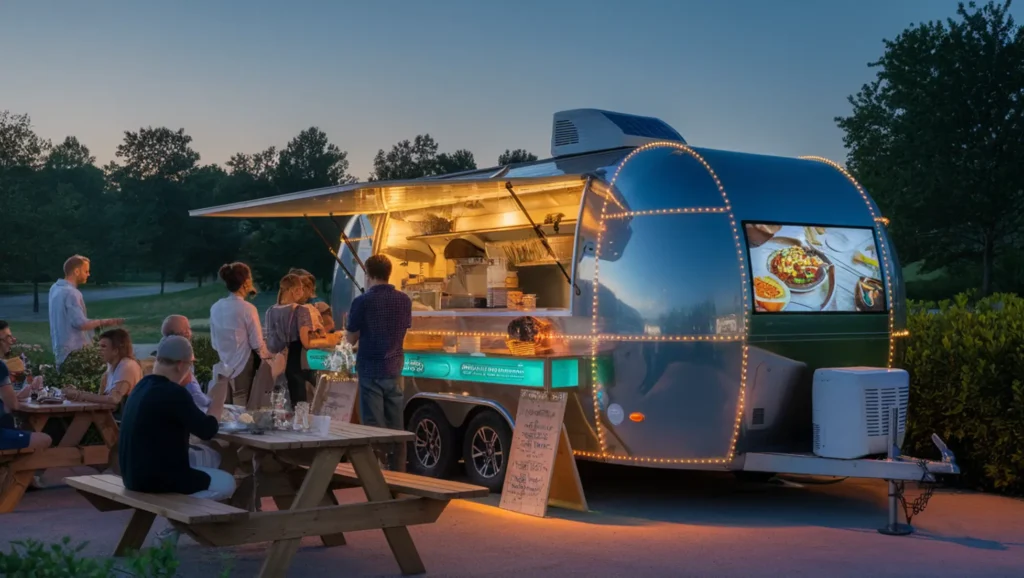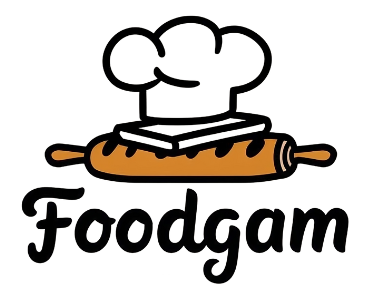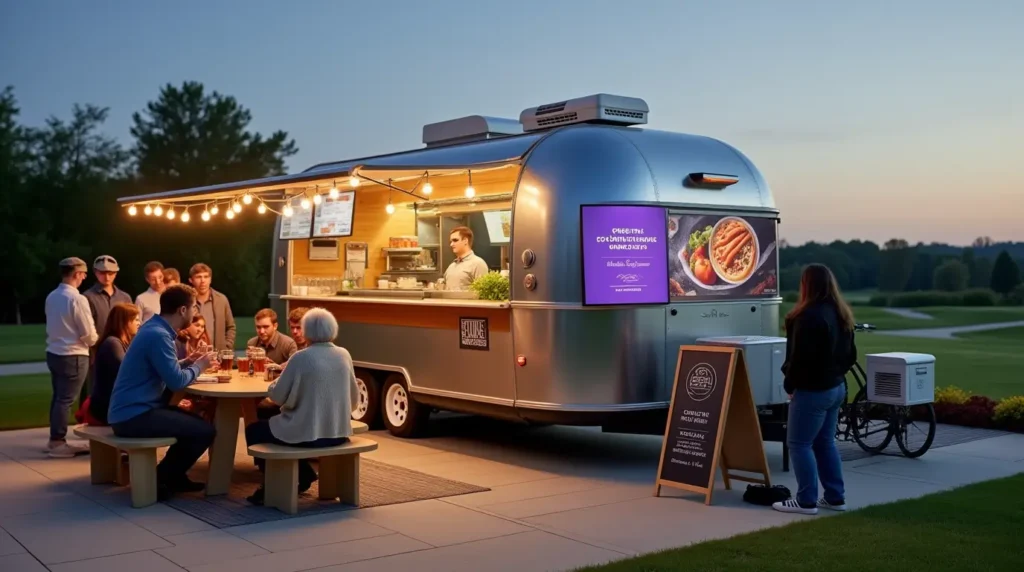Introduction
The food trailer industry is thriving, offering an exciting opportunity for entrepreneurs to enter the culinary world. Learning how to make a food trailer is the first step toward turning your vision into a reality. In fact, food trailers are not only flexible but also profitable, making them a popular choice for aspiring business owners. Above all, this comprehensive guide will walk you through every stage of the process, from choosing the right base trailer to customizing it to perfection. Moreover, you’ll find creative tips, expert advice, and answers to common questions.
In short, if you’re looking to start a food trailer business, this guide is your go-to resource. Let’s dive in!
What You Need to Know Before Making a Food Trailer
Before diving into the step-by-step instructions, it’s important to lay the groundwork for your food trailer project. In addition, understanding the basics will save you time and money in the long run.
1. Research Your Market
- Identify your target audience and the popular cuisines in your area. For instance, a neighborhood with a younger demographic might prefer trendy street food over traditional meals.
- Study your competitors to identify gaps in the market. In fact, finding a unique niche can give you a significant edge.
- Additionally, check your local laws and regulations to ensure your trailer complies with all requirements.
2. Budget Planning
- In short, building a food trailer requires careful budgeting. On the other hand, buying a pre-made trailer might cost more upfront but saves time.
- Factor in hidden costs like permits, maintenance, and insurance. For example, some cities may charge additional fees for operating in high-traffic areas.
3. Trailer Design
Designing your trailer is not just about aesthetics; it’s about creating a functional, efficient, and visually appealing space that works for both you and your customers. Moreover, a well-designed trailer can streamline operations and help you stand out in a competitive market.
First, focus on efficiency. Arrange key elements such as cooking stations, storage, and serving windows in a way that allows for smooth workflow. For instance, keep prep areas close to cooking stations to minimize movement during busy hours. Additionally, ensure that serving windows are positioned for easy customer access without interfering with the kitchen staff. Consequently, this reduces wait times and increases productivity.
Second, prioritize storage. A cluttered trailer can hinder operations, so invest in smart storage solutions. For example, use overhead shelves, magnetic racks for utensils, and under-counter drawers to maximize space. In addition, opt for multi-purpose equipment, such as a combination oven that can bake, grill, and roast, to save on space while maintaining versatility.
Third, consider the aesthetics. The exterior of your food trailer acts as your brand’s first impression. Use bold colors, eye-catching graphics, and clear branding to attract attention. On the other hand, avoid overly complex designs that might confuse or overwhelm potential customers. A clean, professional look is more likely to instill trust and appeal to a broader audience.
Lastly, don’t overlook comfort and safety. Ensure proper ventilation to maintain air quality and prevent overheating. Additionally, use non-slip flooring and fire-resistant materials to create a safe environment for your staff. Add ergonomic features, such as adjustable countertops, to reduce fatigue during long working hours.
In short, a well-planned trailer design not only enhances efficiency but also elevates your brand image, ensuring a seamless and enjoyable experience for both your team and your customers.
Step-by-Step Guide: How to Make a Food Trailer
Step 1: Choose the Right Base Trailer
Choosing the right trailer is the foundation of your food trailer project. In fact, the type of trailer you select will directly impact the functionality, durability, and cost of your build.
For example, if you’re planning a small operation, a 7×14-foot trailer may suffice. This size is ideal for compact kitchens and minimal staff. However, if you envision an extensive menu or expect high customer demand, a larger trailer—such as a 7×20-foot model—would be more suitable.
When deciding between a new or used trailer, weigh the pros and cons carefully. In contrast to new trailers, which are more expensive but come with warranties, used trailers are budget-friendly but may require additional repairs or modifications. Moreover, ensure the trailer has a solid frame, intact flooring, and reliable tires to avoid unexpected costs later.
Step 2: Plan the Layout
Next, focus on designing an efficient kitchen layout. A well-thought-out layout ensures smooth operations, reduces stress, and maximizes productivity during busy hours. Moreover, it creates a professional environment that complies with health and safety regulations.
Start by dividing your space into distinct zones: preparation, cooking, serving, and cleaning. For instance, place your prep station near the refrigerator for quick access to ingredients and position your cooking equipment centrally for optimal workflow. As a result, your team can move seamlessly between tasks without causing bottlenecks.
Additionally, make use of vertical space with overhead shelves for dry goods and magnetic racks for utensils. For example, under-counter cabinets can store bulk items, while hooks can keep tools accessible yet organized. In short, every inch of space should serve a purpose.
Step 3: Install Utilities
Installing essential utilities is critical for a fully operational food trailer. Above all, these systems must meet the health and safety standards set by your local authorities.
Begin with plumbing by adding fresh water and wastewater tanks. For example, most health departments require a minimum 30-gallon freshwater tank and a slightly larger wastewater tank.
Ensure proper ventilation with exhaust fans and hoods. Consequently, this will prevent heat buildup and ensure a safe cooking environment. Electrical systems are equally important, so install a reliable generator or shore power connection to run your equipment smoothly. In addition, energy-efficient appliances should be considered to reduce operating costs.
Step 4: Customize the Exterior
The exterior of your food trailer is like a billboard for your business. In addition, it creates the first impression for potential customers.
Use bold, eye-catching colours and graphics to represent your brand. For instance, if your food trailer specializes in tacos, vibrant designs with Mexican-inspired patterns can instantly communicate your theme. Add a prominent logo and tagline for easy recognition.
Similarly, LED lighting is a valuable addition. It enhances visibility during nighttime operations and adds a professional and inviting touch to your trailer. Because of this, your food trailer will attract customers even after sunset.
Step 5: Equip Your Food Trailer
Equipping your trailer with the right tools and appliances is the final step. Finally, this ensures your kitchen is ready to handle daily operations efficiently and safely.
Start with the essentials: cooking equipment such as grills, fryers, stoves, and ovens. Moreover, include refrigeration units to keep ingredients fresh and storage containers to organize supplies.
Don’t overlook safety gear. Install fire extinguishers and first aid kits to handle emergencies. In addition, non-slip mats on the floor will prevent accidents and keep your staff safe during hectic hours.
Because of this, you’ll create a functional and safe working environment, allowing your team to focus on delivering quality food to your customers.
Conclusion
By following these five steps, you’ll be well on your way to creating a food trailer that’s both functional and attractive. In conclusion, the key to success lies in meticulous planning, smart budgeting, and attention to detail. Whether building from scratch or customizing a pre-owned trailer, every decision matters in creating a mobile kitchen that stands out and thrives in the competitive food trailer market.
Let me know if you want to expand on any specific section or add further refinements!

Creative Tips to Stand Out
Building a successful food trailer business goes beyond the basics of functionality and design. Above all, your ability to stand out in a competitive market will determine your success. Here are some innovative tips to help your food trailer shine.
1. Unique Menu Offerings
Above all, a distinctive menu is the heart of your food trailer’s appeal. Customers are drawn to originality, and creating dishes they can’t find elsewhere gives you a competitive edge.
- Offer signature dishes with a twist. For instance, you could merge two popular cuisines into one, such as Mexican-Asian fusion tacos or Italian-inspired burgers. This fusion approach can captivate adventurous foodies.
- Introduce seasonal specials to keep your menu fresh and exciting. In addition, seasonal ingredients can often be more affordable, improving your bottom line while appealing to eco-conscious customers.
- Highlight locally sourced ingredients to add authenticity to your menu. For example, use regionally famous spices or produce to create dishes that celebrate the local culture.
Additionally, check out this guide for ideas on setting up a food trailer that can accommodate a versatile menu.
2. Eco-Friendly Practices
In addition, sustainability is not just a trend; it’s a value that resonates deeply with modern consumers. Integrating eco-friendly practices into your operations can set your food trailer apart while reducing your environmental impact.
- Use biodegradable packaging to minimize waste. Switching from plastic to paper-based containers or compostable utensils shows your commitment to sustainability.
- Moreover, consider installing solar panels to power your trailer. Solar energy reduces dependency on fossil fuels, cutting operational costs in the long run. As a result, you’ll appeal to eco-conscious customers while saving money.
- Reduce food waste by offering “waste-free specials.” For example, create soups or casseroles from surplus ingredients.
Explore this article on trailer costs to understand cost-effective practices for your trailer.
3. Interactive Features
Adding interactive features to your food trailer enhances customer engagement and creates a memorable experience. For example, these additions can help you build a loyal customer base.
- Add a chalkboard menu where customers can write reviews, feedback, or fun messages. This personal touch can foster a sense of community around your food trailer.
- Similarly, digital screens can elevate your trailer’s appeal. Use them to display promotions, cooking videos, or your food preparation process. As a result, customers are more likely to feel connected to your brand and its story.
- Host interactive events such as “create-your-own-dish” days or live cooking demonstrations. In conclusion, such events not only attract more customers but also generate buzz on social media.
Check out this detailed guide for more inspiration on creative designs and features for your food trailer.
Adding these creative elements to your food trailer will help you stand out in a crowded market. In short, you can turn your food trailer into a thriving business by focusing on a unique menu, eco-friendly practices, and engaging customer experiences. Additionally, explore other resources like this overview of food trailers or this breakdown of food trailer weights to ensure your venture is as innovative as it is efficient.
FAQs About Food Trailers
Q1: Is it cheaper to build or buy a food trailer?
Building a food trailer is generally more affordable if you have DIY skills. However, buying one saves time and effort.
Q2: What is needed in a food trailer?
Essentials include cooking equipment, storage, plumbing, and safety gear. Additionally, check out our detailed list
Q3: Can a food trailer be profitable?
In fact, food trailers can be highly profitable with the right location and menu.
Q4: How much do food trailers make a day?
Earnings vary widely, but successful food trailers can make $500–$3,000 daily. As a result, many entrepreneurs are turning to this business model.

Common Challenges and Solutions
Meeting Health Codes
- Solution: Work closely with your local health department. Additionally, keep detailed records of inspections and certifications.
Managing Space Constraints
- Solution: Invest in compact, multi-functional equipment. For example, combination ovens save space while offering versatility.
Attracting Customers
- Solution: Leverage social media for promotions. In contrast, relying solely on foot traffic might limit your reach.
Conclusion
In conclusion, building a food trailer is a rewarding venture that requires careful planning, creativity, and attention to detail. Moreover, you’ll be well-equipped to launch a successful mobile food business by following the steps outlined in this guide—choosing the right base trailer, designing an efficient layout, installing essential utilities, and incorporating creative elements. Above all, always prioritize quality and customer experience, as these factors will define your reputation and long-term success.
If you’re ready to start your journey, take the time to explore additional resources and inspiration. For instance, check out AllRecipes for menu ideas that can inspire your signature dishes. Similarly, visit Food Network for tips on creating engaging food presentations or Tasty for creative food content that resonates with your target audience. As a result, these resources can give you the edge you need to succeed in a competitive market.
Your dream of owning a food trailer is within reach. With the right tools and knowledge, your mobile kitchen can become a thriving business that delights customers and stands out from the competition. In conclusion, take that first step today and turn your passion for food into a successful enterprise. Let us know how we can help along the way!







